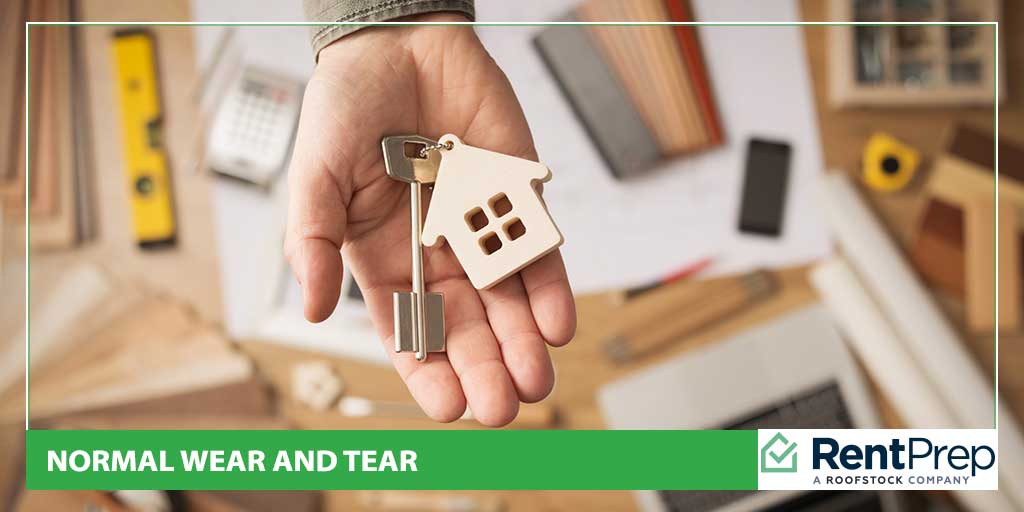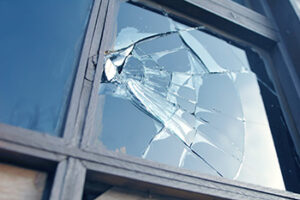
Naturally, some problems will develop at your rental properties over time. The roof will wear out, the floors will lose their luster, and the walls will need to be repainted. Budgeting this normal wear and tear into the cost management of your property is key to keep your bottom line.
But what happens when the damages you find at a rental property after a tenant moves out are beyond the normal wear and tear? What are reasonable charges for tenant damage, and how can you even decide if something is considered “normal” when it comes to wear and tear?
When landlords are doing their move-out inspections, it can be hard to know the right answers to these questions. After all, there isn’t a clean-cut guide you can follow that will tell you what to do. But there are rules, suggestions, and general ideas you should learn so that you can make the right call and protect your investment!
Today, we’ll introduce a suggested normal wear and tear definition as well as some guidelines to follow when determining whether or not something classifies as wear and tear or property damage. Keep all of this in mind as you do your move-out inspections!
A Table Of Contents For Normal Wear And Tear Definition
- What Is Wear And Tear?
- Normal Wear And Tear Vs Damage
- Why You Should Be Inspecting For Potential Property Damage
- Charging For Tenant Damage
- Preventing Future Property Damage
What Is Normal Wear And Tear?
Normal wear and tear is what happens when a tenant uses your property as you intended. It is the natural and expected depreciation of the condition of the property that occurs simply because someone is living there.
For example, the carpet can be expected to be slightly dingier after three years of residency compared to when it was brand new.
This normal wear and tear definition is probably still a little bit vague for your taste, and many landlords would agree with you. One of the big frustrations that landlords have is the inability to have a clearly defined answer about what is and what is not considered to be normal wear and tear.
What Is Considered Normal Wear And Tear?
The answer to this question will ultimately be decided by where you live. In Georgia, for example, the state does not attempt to specifically define what is meant by “wear and tear” in their bylaws.
Texas, on the other hand, has a more specific definition, which can be useful for landlords: “deterioration that results from the intended use of a dwelling…does not include deterioration that results from negligence, carelessness, accident or abuse of the premises, equipment or personal property by the tenant” or their guests.
So, what would qualify as normal deterioration? These are some of the most common examples of normal wear and tear that you will likely see at your property:
- Small smudges or scrapes on walls
- Faded wallpaper or paint
- Sticking doors
- Warped cabinets
- Loose grout
- Mold caused by poor ventilation
- And much more!
We don’t want to intimidate you, but you should know that these examples are just a few of the many items that may be categorized as normal wear and tear.
As a landlord, it’s your responsibility to become familiar with the specifics. To help you accomplish that goal, we’ve put a complete list of normal wear and tear occurrences in our comparison chart below!
Normal Wear And Tear Vs Damage

It’s essential for you to be able to recognize the difference between normal wear and tear and property damage. While you will have to have the issues repaired regardless of how it can be classified, the decision about who pays for the repairs will depend on the classification.
If the problem was caused by regular household use and would have happened regardless of who lived at the property, it is probably an issue of normal wear and tear.
If, however, the problem was explicitly caused by the way that the tenant managed and used the property, you may have a case for property damage.
The Comparison
To help you get a complete picture of what is normal wear and tear and what is not, we’ve created this reference table. We recommend using this to kickstart your inspection learning process!
Of course, this chart is not going to include every single item, but it should help you to gain an understanding of how you can determine whether the problem is from regular use or tenant neglect.
| Household Item/Area | Normal Wear and Tear | Excessive Use; Property Damage |
| Walls | Small nicks, cracks, smudges, scuffs from daily use | Large holes; missing walls. Excessive number of nail holes requiring patchwork |
| Paint | Faded paint or wallpaper | Water damage from indoor plants, unapproved paint or wallpaper, rubbing from furniture |
| Carpet | Faded or worn out from walking | Burns, holes, or stains in carpet. Food and pet stains. |
| Floors | Scuffed from normal use, faded from sunlight | Large chips or gouged floors. Missing tiles or boards. Water stains on wood. |
| Windows | Cracked window pane or sill from normal use and environmental factors | Broken window or windowsill from tenant abuse |
| Window treatments | Dirty or faded window treatments | Missing or ruined window treatments |
| Grout & Tile | Loose grouting or tiles in bathroom, kitchen, etc. | Missing or cracked tiles |
| Mold | Mold caused by ventilation issues | Mold caused by lack of regular cleaning |
| Sinks & Pipes | Rust and clogging caused by age of sink and pipes | Rust and clogging caused by improper use and cleaning |
| Appliances | Filter changes, gasket replacement, small part replacement, which is normal through regular use | Broken parts, accidental dents, missing appliances |
| Cleaning | Regular cleaning of carpets, walls, etc. between tenants | Excessive cleaning because the tenant never cleaned the house while living there |
| Countertops | Scratches and faint watermarks | Deep gouges, excessive staining, burnt areas |
Learn Our Decision Technique
For the areas that aren’t covered in the table above, you still might be at a loss about how to determine whether or not you can charge the tenant for the problem because it was their fault or if you need to take financial responsibility instead.
We’ll walk you through two example situations you might encounter as you work on a move-out inspection. In both of these situations, you’ll need to think critically about the cause of the problems that you find to determine whether or not the issue should be classified as normal wear and tear.
Example #1: Broken Window

When doing a move-out inspection, you notice that one window has some scratches on it and make a note to do a thorough cleaning of it. This is normal wear and tear, and you’ll take care of it.
In another room, however, you find a window that has large cracks running all the way across it. The tenant has taped the window to keep it from entirely breaking, and they never alerted you about this issue previously. When asked, the tenant tells you that something hit it while they were moving out.
As this would be considered property damage, you can deduct the cost of a replacement window, minus depreciation for how long the window has been there, from their security deposit. We’ll go over how to do this type of calculation in more detail a bit later in today’s article.
Example #2: Bathroom Mold & More
When doing a move-out inspection, you find that the mirror in the bathroom has some black spots on it. The mirror has been there for more than 10 years. This process through which black marks form, known as de-silvering, is normal. You cannot charge a tenant for this.
You also notice that there is some mold around the fan in the bathroom, but the tiles and grout in the rest of the bathroom look normal. Additional inspection shows you that the fan was not installed properly, so there is a slight ventilation issue. Since the ventilation is your responsibility as a landlord, you cannot charge a tenant for this either.
Why You Should Be Inspecting For Potential Property Damage
When a tenant causes property damage outside the realm of normal wear and tear, they cost you money. It is not your responsibility to cover the cost of a tenant’s accidents, and it is essential that you check carefully for such property damage when a tenant moves out.
Even if a tenant doesn’t cause any type of damage on purpose, that doesn’t change the fact that you are going to be stuck paying for the repairs if they do not cover the cost. There are a lot of things that you are responsible for as a landlord, but paying for a tenant’s mistakes is not one of them.
Before a tenant moves into your property and after they move out, be sure to do a thorough property inspection. Do not return the security deposit to the tenant until after you are satisfied that the property has been returned in good condition.
Charging For Tenant Damage
After discovering property damage during a move-out inspection, you might be unsure how to proceed with the financing of the necessary repairs. Should you cover the cost, and then bill the tenant? Should you simply take the cost out of their security deposit?
Figuring out what to do with finances in this situation can be confusing, but you are capable of doing just that!
The “Useful Life” Of Rental Properties
Before we continue, understanding the useful life of household items is important.
The useful life of an item is how long it can be expected to be useable for. Unless the household item was brand new when the tenant moved in, you need to consider how much the item has naturally depreciated before determining a repair fee for any property damage.
If, for example, you put in a brand new water heater two years before the tenant moved in and the water heater broke two years later, you would only be able to charge them for 60% of the water heater’s cost if they damaged it since the value has naturally depreciated.
HUD has a list available of recommended life use expectancy for common household items.
Calculating The Cost
To figure out how much to charge a tenant for property damage, you will need to do a few things:
- Find out the original useable life of the item.
- Calculate what percent of useable life the item had left prior to being damaged.
- Get a quote from a licensed contractor or store for the item’s replacement.
- Multiply the percent from Step 2 by the quoted amount in Step 3.
- The number from Step 4 is the final cost.
Let’s work through an example to make that process more clear. Let’s say that you painted the walls of the apartment right before a tenant moved in. They painted over the walls without permission and moved out one year later. The paint would have been good for another four years, so the tenant is responsible for 80% of the replacement cost.
Security Deposit Deductions
Once you have the final cost of repair, you can deduct this from the security deposit. Then, write up a list of deductions to mail to the tenant when you return their security deposit. Be sure to keep all repair receipts and bank records as proof of the money being returned properly.
In some states, there are only specific things that you can withhold from the security deposit, and all states have their own limitations on how long you have to return the deposit after the tenant moves out. Be sure that you brush up your local laws about security deposits before withholding or deducting anything from the balance.
Preventing Property Damage
Normal wear and tear in the rental business is a complicated concept. Landlords and tenants tend to understand what the word “normal” means from their own perspective, so it can be a touchy area to navigate no matter how many years of experience you have.
As you learn more about property damage that can occur in rental properties, however, you will become more adept at finding ways to prevent such damage before it even occurs. We have two big suggestions we believe can help you protect your properties.
Make The Requirements Clear
The number one thing that you need to do is make sure that your lease clearly states the maintenance and cleaning requirements that you expect your tenant to maintain as well as what will happen if they move out without following those requirements.
Specifically, be sure that your lease explains the following:
- How move-in and move-out inspections will work
- If the tenant needs to pay for carpet cleaning or repaint the walls when moving out
- What type of cleaning should be done when they leave
- What qualifies as normal wear and tear and what doesn’t
- What will happen if you find property damage when they move out
- How their security deposit works
These are all things you should already have clearly included in your lease, but double check you have covered each one of these bullet points before you rent to your next tenant. Trust us when we say that it’ll make a world of difference if you have a property damage problem in the future!
Choose The Best Tenants Around
Another thing you can do to help prevent any issues with normal wear and tear vs damage is to choose tenants who are going to respect the property as much as you do. Great tenants will treat your rental property as if it is their own, and that care will show through when you do your move-out inspection.
To find the best tenants, try using a tenant screening service to streamline your selection experience and narrow your choices to the best of the best.
Normal Wear And Tear: Don’t Let It Tear You Down!
Don’t let the fear of not knowing how to classify a problem at one of your rental properties prevent you from being able to turn the profit that you have worked hard for. When you pay for tenant damages instead of holding them responsible, you are losing out on money that you earned.
That is a big part of why it is so important to learn about the differences between normal wear and tenant-caused damage, so make sure that you keep this information in mind as you work through your next inspections.
Don’t forget:
- Any problems caused by tenant neglect can be considered property damage.
- Any problems caused by natural deterioration are to be considered normal wear and tear.
- Any problems caused by landlord neglect are your responsibility to fix.
- Move-in and move-out inspections are essential.
With the tips we’ve shared today, we know that your next rental property transition between tenants is sure to go smoothly in both finances and practice!

